3.1E: Exercises for Section 3.1
- Page ID
- 93367
\( \newcommand{\vecs}[1]{\overset { \scriptstyle \rightharpoonup} {\mathbf{#1}} } \)
\( \newcommand{\vecd}[1]{\overset{-\!-\!\rightharpoonup}{\vphantom{a}\smash {#1}}} \)
\( \newcommand{\id}{\mathrm{id}}\) \( \newcommand{\Span}{\mathrm{span}}\)
( \newcommand{\kernel}{\mathrm{null}\,}\) \( \newcommand{\range}{\mathrm{range}\,}\)
\( \newcommand{\RealPart}{\mathrm{Re}}\) \( \newcommand{\ImaginaryPart}{\mathrm{Im}}\)
\( \newcommand{\Argument}{\mathrm{Arg}}\) \( \newcommand{\norm}[1]{\| #1 \|}\)
\( \newcommand{\inner}[2]{\langle #1, #2 \rangle}\)
\( \newcommand{\Span}{\mathrm{span}}\)
\( \newcommand{\id}{\mathrm{id}}\)
\( \newcommand{\Span}{\mathrm{span}}\)
\( \newcommand{\kernel}{\mathrm{null}\,}\)
\( \newcommand{\range}{\mathrm{range}\,}\)
\( \newcommand{\RealPart}{\mathrm{Re}}\)
\( \newcommand{\ImaginaryPart}{\mathrm{Im}}\)
\( \newcommand{\Argument}{\mathrm{Arg}}\)
\( \newcommand{\norm}[1]{\| #1 \|}\)
\( \newcommand{\inner}[2]{\langle #1, #2 \rangle}\)
\( \newcommand{\Span}{\mathrm{span}}\) \( \newcommand{\AA}{\unicode[.8,0]{x212B}}\)
\( \newcommand{\vectorA}[1]{\vec{#1}} % arrow\)
\( \newcommand{\vectorAt}[1]{\vec{\text{#1}}} % arrow\)
\( \newcommand{\vectorB}[1]{\overset { \scriptstyle \rightharpoonup} {\mathbf{#1}} } \)
\( \newcommand{\vectorC}[1]{\textbf{#1}} \)
\( \newcommand{\vectorD}[1]{\overrightarrow{#1}} \)
\( \newcommand{\vectorDt}[1]{\overrightarrow{\text{#1}}} \)
\( \newcommand{\vectE}[1]{\overset{-\!-\!\rightharpoonup}{\vphantom{a}\smash{\mathbf {#1}}}} \)
\( \newcommand{\vecs}[1]{\overset { \scriptstyle \rightharpoonup} {\mathbf{#1}} } \)
\( \newcommand{\vecd}[1]{\overset{-\!-\!\rightharpoonup}{\vphantom{a}\smash {#1}}} \)
For exercises 1 - 10, use the equation \( m_{\text{sec}}=\dfrac{f(x)−f(a)}{x−a} \) to find the slope of the secant line between the values \(x_1\) and \(x_2\) for each function \(y=f(x)\).
1) \(f(x)=4x+7; \quad x_1=2, \quad x_2=5\)
- Answer
- \(m_{\text{sec}}=4\)
2) \(f(x)=8x−3;\quad x_1=−1,\quad x_2=3\)
3) \(f(x)=x^2+2x+1;\quad x_1=3,\quad x_2=3.5\)
- Answer
- \(m_{\text{sec}}=8.5\)
4) \(f(x)=−x^2+x+2;\quad x_1=0.5,\quad x_2=1.5\)
5) \(f(x)=\dfrac{4}{3x−1};\quad x_1=1,\quad x_2=3\)
- Answer
- \(m_{\text{sec}}=−\frac{3}{4}\)
6) \(f(x)=\dfrac{x−7}{2x+1};\quad x_1=−2,\quad x_2=0\)
7) \(f(x)=\sqrt{x};\quad x_1=1,\quad x_2=16\)
- Answer
- \(m_{\text{sec}}=0.2\)
8) \(f(x)=\sqrt{x−9};\quad x_1=10,\quad x_2=13\)
9) \(f(x)=x^{1/3}+1;\quad x_1=0,\quad x_2=8\)
- Answer
- \(m_{\text{sec}}=0.25\)
10) \(f(x)=6x^{2/3}+2x^{1/3};\quad x_1=1,\quad x_2=27\)
For the functions in exercises 11 - 20,
a. use the equation \( \displaystyle m_{\text{tan}}=\lim_{h→0}\frac{f(a+h)−f(a)}{h} \) to find the slope of the tangent line \(m_{\text{tan}}=f′(a)\), and
b. find the equation of the tangent line to \(f\) at \(x=a\).
11) \(f(x)=3−4x, \quad a=2\)
- Answer
- a. \(m_{\text{tan}}=−4\)
b. \(y=−4x+3\)
12) \(f(x)=\dfrac{x}{5}+6, \quad a=−1\)
13) \(f(x)=x^2+x, \quad a=1\)
- Answer
- a. \(m_{\text{tan}}=3\)
b. \(y=3x−1\)
14) \(f(x)=1−x−x^2, \quad a=0\)
15) \(f(x)=\dfrac{7}{x}, \quad a=3\)
- Answer
- a. \(m_{\text{tan}}=\frac{−7}{9}\)
b. \(y=\frac{−7}{9}x+\frac{14}{3}\)
16) \(f(x)=\sqrt{x+8}, \quad a=1\)
17) \(f(x)=2−3x^2, \quad a=−2\)
- Answer
- a. \(m_{\text{tan}}=12\)
b. \(y=12x+14\)
18) \(f(x)=\dfrac{−3}{x−1}, \quad a=4\)
19) \(f(x)=\dfrac{2}{x+3}, \quad a=−4\)
- Answer
- a. \(m_{\text{tan}}=−2\)
b. \(y=−2x−10\)
20) \(f(x)=\dfrac{3}{x^2}, \quad a=3\)
For the functions \(y=f(x)\) in exercises 21 - 30, find \(f′(a)\) using the equation \( \displaystyle f′(a)=\lim_{x→a}\frac{f(x)−f(a)}{x−a} \).
21) \(f(x)=5x+4, \quad a=−1\)
- Answer
- \(f'(-1) = 5\)
22) \(f(x)=−7x+1, \quad a=3\)
23) \(f(x)=x^2+9x, \quad a=2\)
- Answer
- \(f'(2) = 13\)
24) \(f(x)=3x^2−x+2, \quad a=1\)
25) \(f(x)=\sqrt{x}, \quad a=4\)
- Answer
- \(f'(4) = \frac{1}{4}\)
26) \(f(x)=\sqrt{x−2}, \quad a=6\)
27) \(f(x)=\dfrac{1}{x}, \quad a=2\)
- Answer
- \(f'(2) = −\frac{1}{4}\)
28) \(f(x)=\dfrac{1}{x−3}, \quad a=−1\)
29) \(f(x)=\dfrac{1}{x^3}, \quad a=1\)
- Answer
- \(f'(1) = -3\)
30) \(f(x)=\dfrac{1}{\sqrt{x}}, \quad a=4\)
For the following exercises, given the function \(y=f(x)\),
a. find the slope of the secant line \(PQ\) for each point \(Q(x,f(x))\) with \(x\) value given in the table.
b. Use the answers from a. to estimate the value of the slope of the tangent line at \(P\).
c. Use the answer from b. to find the equation of the tangent line to \(f\) at point \(P\).
31) [T] \(f(x)=x^2+3x+4, \quad P(1,8)\) (Round to \(6\) decimal places.)
| \(x\) | \(Slope m_{PQ}\) | \(x\) | \(Slope m_{PQ}\) |
| 1.1 | (i) | 0.9 | (vii) |
| 1.01 | (ii) | 0.99 | (viii) |
| 1.001 | (iii) | 0.999 | (ix) |
| 1.0001 | (iv) | 0.9999 | (x) |
| 1.00001 | (v) | 0.99999 | (xi) |
| 1.000001 | (vi) | 0.999999 | (xii) |
- Answer
- \(a. (i)5.100000, (ii)5.010000, (iii)5.001000, (iv)5.000100, (v)5.000010, (vi)5.000001, (vii)4.900000, (viii)4.990000, (ix)4.999000, (x)4.999900, (xi)4.999990, (x)4.999999\)
b. \(m_{\text{tan}}=5\)
c. \(y=5x+3\)
32) [T] \(f(x)=\dfrac{x+1}{x^2−1}, \quad P(0,−1)\)
| \(x\) | \(Slope m_{PQ}\) | \(x\) | \(Slope m_{PQ}\) |
| 0.1 | (i) | −0.1 | (vii) |
| 0.01 | (ii) | −0.01 | (viii) |
| 0.001 | (iii) | −0.001 | (ix) |
| 0.0001 | (iv) | −0.0001 | (x) |
| 0.00001 | (v) | −0.00001 | (xi) |
| 0.000001 | (vi) | −0.000001 | (xii) |
33) [T] \(f(x)=10e^{0.5x}, \quad P(0,10)\) (Round to \(4\) decimal places.)
| \(x\) | \(Slope m_{PQ}\) |
| −0.1 | (i) |
| −0.01 | (ii) |
| −0.001 | (iii) |
| −0.0001 | (iv) |
| −0.00001 | (v) |
| −0.000001 | (vi) |
- Answer
- a. \((i)4.8771, \;(ii)4.9875, \;(iii)4.9988, \;(iv)4.9999, \;(v)4.9999, \;(vi)4.9999 \)
b. \(m_{\text{tan}}=5\)
c. \(y=5x+10\)
34) [T] \(f(x)=\tan(x), \quad P(π,0)\)
| \(x\) | \(Slope m_{PQ}\) |
| 3.1 | (i) |
| 3.14 | (ii) |
| 3.141 | (iii) |
| 3.1415 | (iv) |
| 3.14159 | (v) |
| 3.141592 | (vi) |
[T] For the following position functions \(y=s(t)\), an object is moving along a straight line, where \(t\) is in seconds and \(s\) is in meters. Find
a. the simplified expression for the average velocity from \(t=2\) to \(t=2+h\);
b. the average velocity between \(t=2\) and \(t=2+h\), where \((i)\;h=0.1, \;(ii)\;h=0.01, \;(iii)\;h=0.001\), and \((iv)\;h=0.0001\); and
c. use the answer from a. to estimate the instantaneous velocity at \(t=2\) second.
35) \(s(t)=\frac{1}{3}t+5\)
- Answer
- a. \(\frac{1}{3}\);
b. \((i)\;\frac{1}{3}\) m/s, \((ii)\;\frac{1}{3}\) m/s, \((iii)\;\frac{1}{3}\) m/s, \((iv)\;\frac{1}{3}\) m/s;
c. \(\frac{1}{3}\) m/s
36) \(s(t)=t^2−2t\)
37) \(s(t)=2t^3+3\)
- Answer
- a. \(2(h^2+6h+12)\);
b. \((i)\;25.22\) m/s, \((ii)\; 24.12\) m/s, \((iii)\; 24.01\) m/s, \((iv)\; 24\) m/s;
c. \(24\) m/s
38) \(s(t)=\dfrac{16}{t^2}−\dfrac{4}{t}\)
39) Use the following graph to evaluate a. \(f′(1)\) and b. \(f′(6).\)
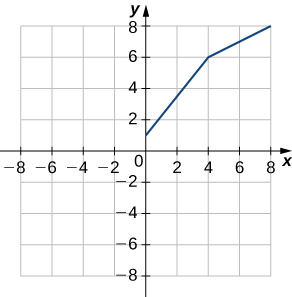
- Answer
- a. \(1.25\); b. \(0.5\)
40) Use the following graph to evaluate a. \(f′(−3)\) and b. \(f′(1.5)\).
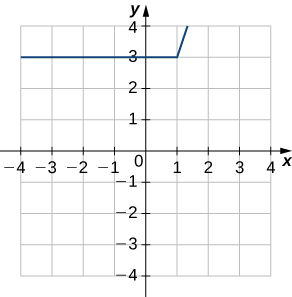
For the following exercises, use the limit definition of derivative to show that the derivative does not exist at \(x=a\) for each of the given functions.
41) \(f(x)=x^{1/3}, \quad x=0\)
- Answer
- \(\displaystyle \lim_{x→0^−}\frac{x^{1/3}−0}{x−0}=\lim_{x→0^−}\frac{1}{x^{2/3}}=∞\)
42) \(f(x)=x^{2/3}, \quad x=0\)
43) \(f(x)=\begin{cases}1, & \text{if } x<1\\x, & \text{if } x≥1\end{cases}, \quad x=1\)
- Answer
- \(\displaystyle \lim_{x→1^−}\frac{1−1}{x−1}=0≠1=\lim_{x→1^+}\frac{x−1}{x−1}\)
44) \(f(x)=\dfrac{|x|}{x}, \quad x=0\)
45) [T] The position in feet of a race car along a straight track after \(t\) seconds is modeled by the function \(s(t)=8t^2−\frac{1}{16}t^3.\)
a. Find the average velocity of the vehicle over the following time intervals to four decimal places:
i. [\(4, 4.1\)]
ii. [\(4, 4.01\)]
iii. [\(4, 4.001\)]
iv. [\(4, 4.0001\)]
b. Use a. to draw a conclusion about the instantaneous velocity of the vehicle at \(t=4\) seconds.
- Answer
- a. \((i)61.7244 ft/s, \;(ii)61.0725 ft/s, \;(iii)61.0072 ft/s, \;(iv)61.0007 ft/s\)
b. At \(4\) seconds the race car is traveling at a rate/velocity of \(61\) ft/s.
46) [T] The distance in feet that a ball rolls down an incline is modeled by the function \(s(t)=14t^2\),
where t is seconds after the ball begins rolling.
a. Find the average velocity of the ball over the following time intervals:
i. [5, 5.1]
ii. [5, 5.01]
iii. [5, 5.001]
iv. [5, 5.0001]
b. Use the answers from a. to draw a conclusion about the instantaneous velocity of the ball at \(t=5\) seconds.
47) Two vehicles start out traveling side by side along a straight road. Their position functions, shown in the following graph, are given by \(s=f(t)\) and \(s=g(t)\), where s is measured in feet and t is measured in seconds.
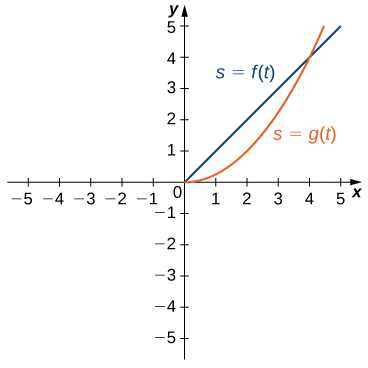
a. Which vehicle has traveled farther at \(t=2\) seconds?
b. What is the approximate velocity of each vehicle at \(t=3\) seconds?
c. Which vehicle is traveling faster at \(t=4\) seconds?
d. What is true about the positions of the vehicles at \(t=4\) seconds?
- Answer
- a. The vehicle represented by \(f(t)\), because it has traveled \(2\) feet, whereas \(g(t)\) has traveled \(1\) foot.
b. The velocity of \(f(t)\) is constant at \(1\) ft/s, while the velocity of \(g(t)\) is approximately \(2\) ft/s.
c. The vehicle represented by \(g(t)\), with a velocity of approximately \(4\) ft/s.
d. Both have traveled \(4\) feet in \(4\) seconds.
48) [T] The total cost \(C(x)\), in hundreds of dollars, to produce \(x\) jars of mayonnaise is given by \(C(x)=0.000003x^3+4x+300\).
a. Calculate the average cost per jar over the following intervals:
i. [100, 100.1]
ii. [100, 100.01]
iii. [100, 100.001]
iv. [100, 100.0001]
b. Use the answers from a. to estimate the average cost to produce \(100\) jars of mayonnaise.
49) [T] For the function \(f(x)=x^3−2x^2−11x+12\), do the following.
a. Use a graphing calculator to graph \(f\) in an appropriate viewing window.
b. Use the ZOOM feature on the calculator to approximate the two values of \(x=a\) for which \(m_{tan}=f′(a)=0\).
- Answer
-
a.
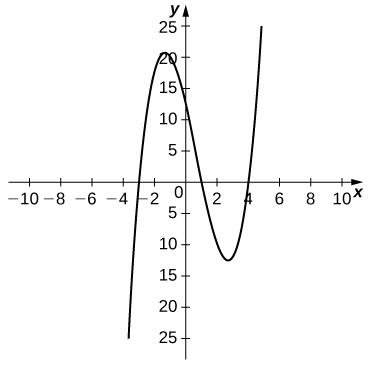
b. \(a≈−1.361,\;2.694\)
50) [T] For the function \(f(x)=\dfrac{x}{1+x^2}\), do the following.
a. Use a graphing calculator to graph \(f\) in an appropriate viewing window.
b. Use the ZOOM feature on the calculator to approximate the values of \(x=a\) for which \(m_{\text{tan}}=f′(a)=0\).
51) Suppose that \(N(x)\) computes the number of gallons of gas used by a vehicle traveling \(x\) miles. Suppose the vehicle gets \(30\) mpg.
a. Find a mathematical expression for \(N(x)\).
b. What is \(N(100)\)? Explain the physical meaning.
c. What is \(N′(100)\)? Explain the physical meaning.
- Answer
- a. \(N(x)=\dfrac{x}{30}\)
b. ∼\(3.3\) gallons. When the vehicle travels \(100\) miles, it has used \(3.3\) gallons of gas.
c. \(\frac{1}{30}\). The rate of gas consumption in gallons per mile that the vehicle is achieving after having traveled \(100\) miles.
52) [T] For the function \(f(x)=x^4−5x^2+4\), do the following.
a. Use a graphing calculator to graph \(f\) in an appropriate viewing window.
b. Use the \(nDeriv\) function, which numerically finds the derivative, on a graphing calculator to estimate \(f′(−2),\;f′(−0.5),\;f′(1.7)\), and \(f′(2.718)\).
53) [T] For the function \(f(x)=\dfrac{x^2}{x^2+1}\), do the following.
a. Use a graphing calculator to graph \(f\) in an appropriate viewing window.
b. Use the \(nDeriv\) function on a graphing calculator to find \(f′(−4),\;f′(−2),\;f′(2)\), and \(f′(4)\).
- Answer
-
a.
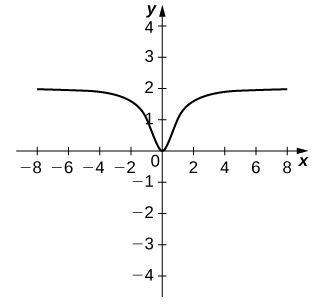
b. \(−0.028,−0.16,0.16,0.028\)
For exercises 54 - 63, use the definition of a derivative to find \(f′(x)\).
54) \(f(x)=6\)
55) \(f(x)=2−3x\)
- Answer
- \(f'(x) = −3\)
56) \(f(x)=\dfrac{2x}{7}+1\)
57) \(f(x)=4x^2\)
- Answer
- \(f'(x) = 8x\)
58) \(f(x)=5x−x^2\)
59) \(f(x)=\sqrt{2x}\)
- Answer
- \(f'(x) = \dfrac{1}{\sqrt{2x}}\)
60) \(f(x)=\sqrt{x−6}\)
61) \(f(x)=\dfrac{9}{x}\)
- Answer
- \(f'(x)=\dfrac{−9}{x^2}\)
62) \(f(x)=x+\dfrac{1}{x}\)
63) \(f(x)=\dfrac{1}{\sqrt{x}}\)
- Answer
- \(f'(x)=\dfrac{−1}{2x^{3/2}}\)
For the exercises 64 - 67, use the graph of \(y=f(x)\) to sketch the graph of its derivative \(f′(x)\).
64)
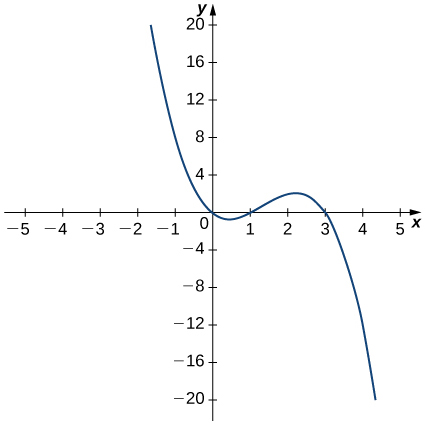
65)
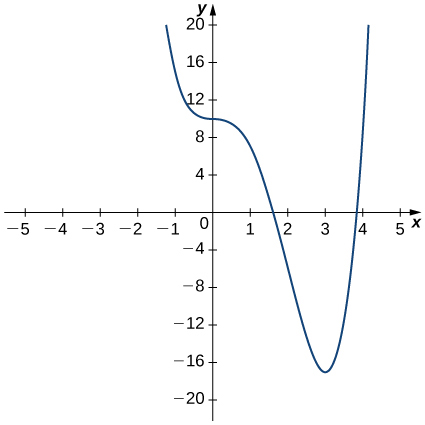
- Answer
-
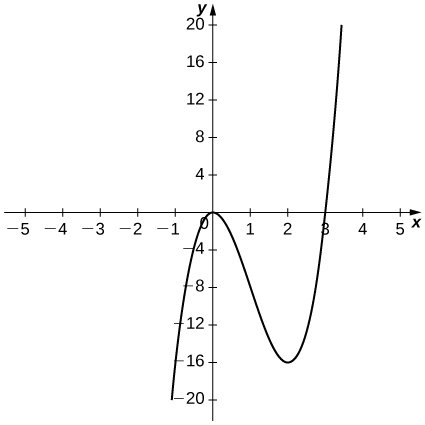
66)
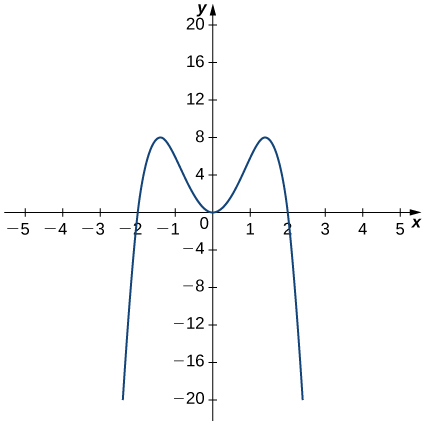
67)
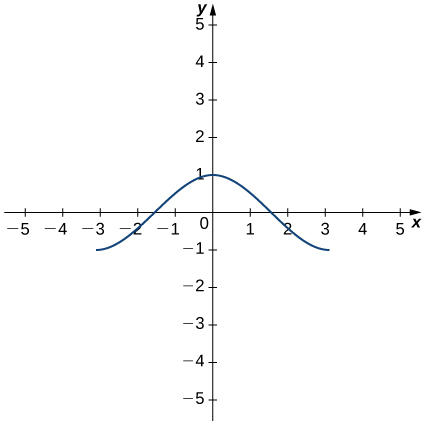
- Answer
-
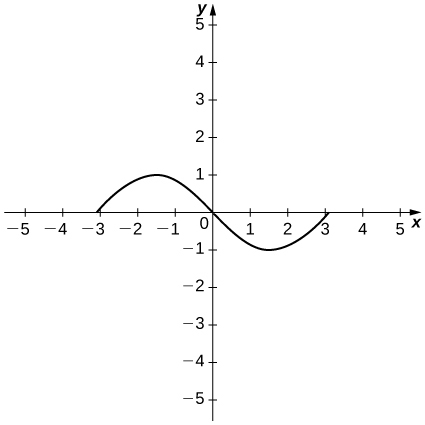
For exercises 68 - 73, the given limit represents the derivative of a function \(y=f(x)\) at \(x=a\). Find \(f(x)\) and \(a\).
68) \(\displaystyle \lim_{h→0}\frac{(1+h)^{2/3}−1}{h}\)
69) \(\displaystyle \lim_{h→0}\frac{[3(2+h)^2+2]−14}{h}\)
- Answer
- \(f(x)=3x^2+2, \quad a=2\)
70) \(\displaystyle \lim_{h→0}\frac{\cos(π+h)+1}{h}\)
71) \(\displaystyle \lim_{h→0}\frac{(2+h)^4−16}{h}\)
- Answer
- \(f(x)=x^4, \quad a=2\)
72) \(\displaystyle \lim_{h→0}\frac{[2(3+h)^2−(3+h)]−15}{h}\)
73) \(\displaystyle \lim_{h→0}\frac{e^h−1}{h}\)
- Answer
- \(f(x)=e^x, \quad a=0\)
For the functions in exercises 74 - 77,
a. sketch the graph and
b. use the definition of a derivative to show that the function is not differentiable at \(x=1\).
74) \(f(x)=\begin{cases}2\sqrt{x}, & \text{if } 0≤x≤1\\3x−1, & \text{if } x>1\end{cases}\)
75) \(f(x)=\begin{cases}3, & \text{if } x<1\\3x, & \text{if } x≥1\end{cases}\)
- Answer
-
a.
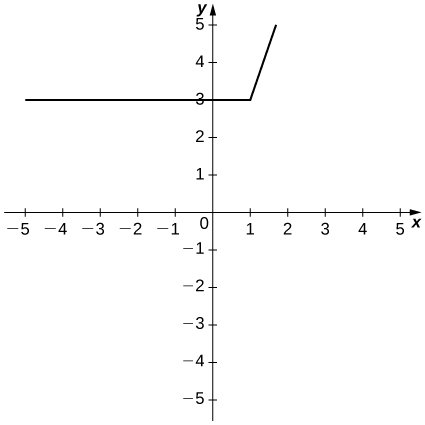
b. \(\displaystyle \lim_{h→1^−}\frac{3−3}{h}≠\lim_{h→1^+}\frac{3h}{h}\)
76) \(f(x)=\begin{cases}−x^2+2, & \text{if } x≤1\\x, & \text{if } x>1\end{cases}\)
77) \(f(x)=\begin{cases}2x, & \text{if } x≤1\\\frac{2}{x}, & \text{if } x>1\end{cases}\)
- Answer
-
a.
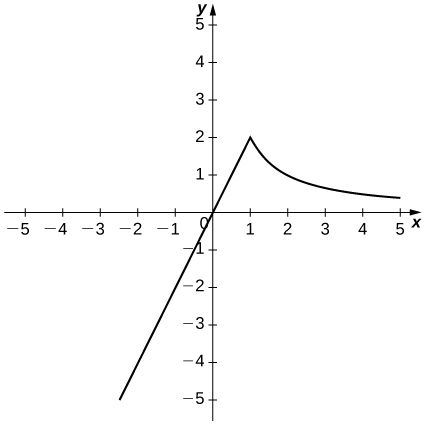
b. \(\displaystyle \lim_{h→1^−}\frac{2h}{h}≠\lim_{h→1^+}\frac{\frac{2}{x+h}−2x}{h}.\)
For the graphs in exercises 78 - 79,
a. determine for which values of \(x=a\) the \(\displaystyle \lim_{x→a}f(x)\) exists but \(f\) is not continuous at \(x=a\), and
b. determine for which values of \(x=a\) the function is continuous but not differentiable at \(x=a\).
78)
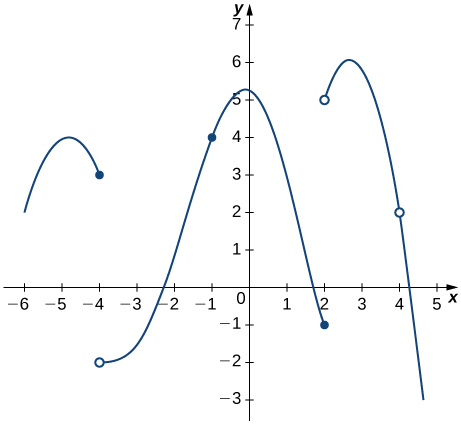
79)
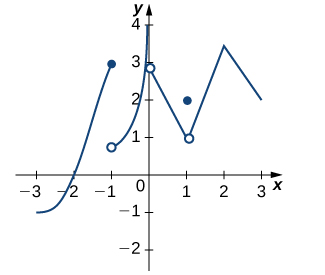
- Answer
- a. \(x=1\),
b. \(x=2\)
80) Use the graph to evaluate a. \(f′(−0.5)\), b. \(f′(0)\), c. \(f′(1)\), d. \(f′(2)\), and e. \(f′(3),\) if it exists.
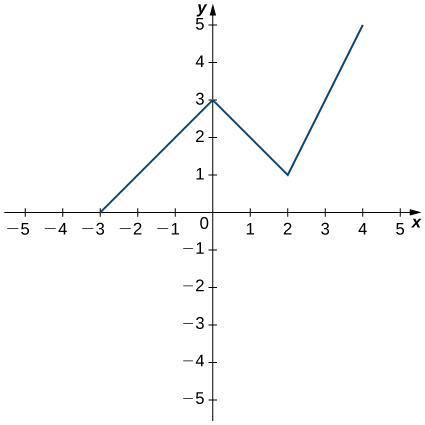
For the functions in exercises 81 - 83, use \(f''(x)=\displaystyle \lim_{h→0}\frac{f′(x+h)−f′(x)}{h}\) to find \(f''(x).\)
81) \(f(x)=2−3x\)
- Answer
- \(f''(x)=0\)
82) \(f(x)=4x^2\)
83) \(f(x)=x+\dfrac{1}{x}\)
- Answer
- \(f''(x)=\dfrac{2}{x^3}\)
For exercises 84 - 89, use a calculator to graph \(f(x)\). Determine the function \(f′(x)\), then use a calculator to graph \(f′(x)\).
84) [T] \(f(x)=−\dfrac{5}{x}\)
85) [T] \(f(x)=3x^2+2x+4.\)
- Answer
-
\(f′(x)=6x+2\)
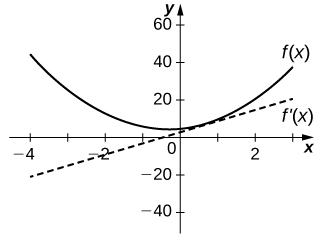
86) [T] \(f(x)=\sqrt{x}+3x\)
87) [T] \(f(x)=\dfrac{1}{\sqrt{2x}}\)
- Answer
-
\(f′(x)=−\dfrac{1}{(2x)^{3/2}}\)
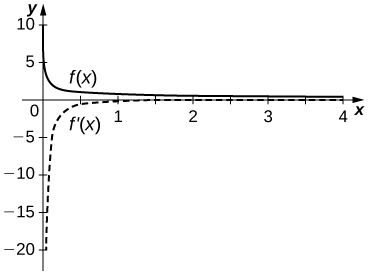
88) [T] \(f(x)=1+x+\dfrac{1}{x}\)
89) [T] \(f(x)=x^3+1\)
- Answer
-
\(f′(x)=3x^2\)
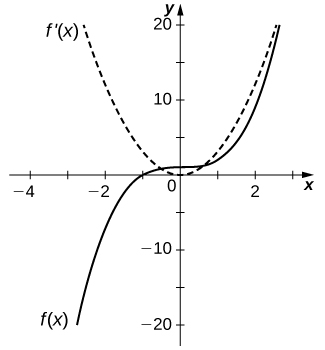
For exercises 90 - 95, describe what the two expressions represent in terms of each of the given situations. Be sure to include units.
a. \(\dfrac{f(x+h)−f(x)}{h}\)
b. \(f′(x)=\displaystyle \lim_{h→0}\frac{f(x+h)−f(x)}{h}\)
90) \(P(x)\) denotes the population of a city at time \(x\) in years.
91) \(C(x)\) denotes the total amount of money (in thousands of dollars) spent on concessions by \(x\) customers at an amusement park.
- Answer
-
a. Average rate at which customers spent on concessions in thousands per customer.
b. Rate (in thousands per customer) at which \(x\) customers spent money on concessions in thousands per customer.
92) \(R(x)\) denotes the total cost (in thousands of dollars) of manufacturing \(x\) clock radios
93) \(g(x)\) denotes the grade (in percentage points) received on a test, given \(x\) hours of studying.
- Answer
-
a. Average grade received on the test with an average study time between two values.
b. Rate (in percentage points per hour) at which the grade on the test increased or decreased for a given average study time of \(x\) hours.
94) \(B(x) \)denotes the cost (in dollars) of a sociology textbook at university bookstores in the United States in \(x\) years since \(1990\).
95) \(p(x)\) denotes atmospheric pressure at an altitude of \(x\) feet.
- Answer
-
a. Average change of atmospheric pressure between two different altitudes.
b. Rate (torr per foot) at which atmospheric pressure is increasing or decreasing at \(x\) feet.
96) Sketch the graph of a function \(y=f(x)\) with all of the following properties:
a. \(f′(x)>0\) for \(−2≤x<1\)
b. \(f′(2)=0\)
c. \(f′(x)>0\) for \(x>2\)
d. \(f(2)=2\) and \(f(0)=1\)
e. \(\displaystyle \lim_{x→−∞}f(x)=0\) and \(\displaystyle \lim_{x→∞}f(x)=∞\)
f. \(f′(1)\) does not exist.
97) Suppose temperature \(T\) in degrees Fahrenheit at a height \(x\) in feet above the ground is given by \(y=T(x).\)
a. Give a physical interpretation, with units, of \(T′(x).\)
b. If we know that \(T′(1000)=−0.1,\) explain the physical meaning.
- Answer
-
a. The rate (in degrees per foot) at which temperature is increasing or decreasing for a given height \(x.\)
b. The rate of change of temperature as altitude changes at \(1000\) feet is \(−0.1\) degrees per foot.
98) Suppose the total profit of a company is \(y=P(x)\) thousand dollars when \(x\) units of an item are sold.
a. What does \(\dfrac{P(b)−P(a)}{b−a}\) for \(0<a<b\) measure, and what are the units?
b. What does \(P′(x)\) measure, and what are the units?
c. Suppose that \(P′(30)=5\), what is the approximate change in profit if the number of items sold increases from \(30\) to \(31\)?
99) The graph in the following figure models the number of people \(N(t)\) who have come down with the flu t weeks after its initial outbreak in a town with a population of 50,000 citizens.
a. Describe what \(N′(t)\) represents and how it behaves as \(t\) increases.
b. What does the derivative tell us about how this town is affected by the flu outbreak?
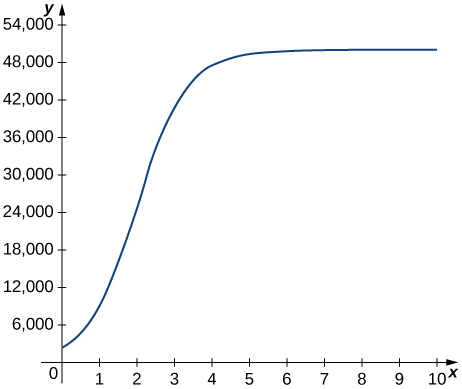
- Answer
- a. The rate at which the number of people who have come down with the flu is changing \(t\) weeks after the initial outbreak.
b. The rate is increasing sharply up to the third week, at which point it slows down and then becomes constant.
For exercises 100 - 105, use the following table, which shows the height \(h\) of the Saturn V rocket for the Apollo 11 mission \(t\) seconds after launch.
| Time (seconds) | Height (meters) |
| 0 | 0 |
| 1 | 2 |
| 2 | 4 |
| 3 | 13 |
| 4 | 25 |
| 5 | 32 |
100) What is the physical meaning of \(h′(t)\)? What are the units?
101) [T] Construct a table of values for \(h′(t)\) and graph both \(h(t)\) and \(h′(t)\) on the same graph. (Hint: for interior points, estimate both the left limit and right limit and average them.)
- Answer
-
Time (seconds) \(h′(t)\) (m/s) 0 2 1 2 2 5.5 3 10.5 4 9.5 5 7
102) [T] The best linear fit to the data is given by \(H(t)=7.229t−4.905\), where \(H\) is the height of the rocket (in meters) and t is the time elapsed since takeoff. From this equation, determine \(H′(t)\). Graph \(H(t\) with the given data and, on a separate coordinate plane, graph \(H′(t).\)
103) [T] The best quadratic fit to the data is given by \(G(t)=1.429t^2+0.0857t−0.1429,\) where \(G\) is the height of the rocket (in meters) and \(t\) is the time elapsed since takeoff. From this equation, determine \(G′(t)\). Graph \(G(t)\) with the given data and, on a separate coordinate plane, graph \(G′(t).\)
- Answer
-
\(G′(t)=2.858t+0.0857\)
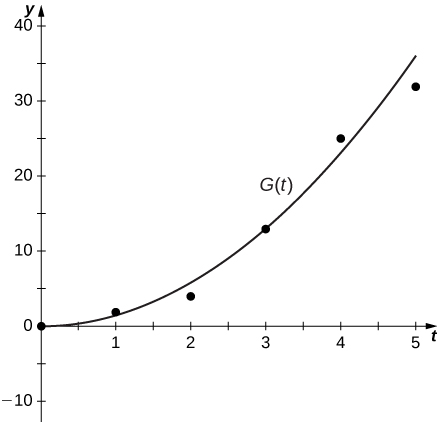
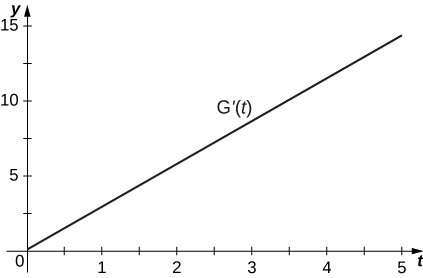
104) [T] The best cubic fit to the data is given by \(F(t)=0.2037t^3+2.956t^2−2.705t+0.4683\), where \(F\) is the height of the rocket (in m) and \(t\) is the time elapsed since take off. From this equation, determine \(F′(t)\). Graph \(F(t)\) with the given data and, on a separate coordinate plane, graph \(F′(t)\). Does the linear, quadratic, or cubic function fit the data best?
105) Using the best linear, quadratic, and cubic fits to the data, determine what \(H''(t),\;G''(t)\text{ and }F''(t)\) are. What are the physical meanings of \(H''(t),\;G''(t )\text{ and }F''(t),\) and what are their units?
- Answer
- \(H''(t)=0,\;G''(t)=2.858\text{ and }f''(t)=1.222t+5.912\) represent the acceleration of the rocket, with units of meters per second squared \((\text{m/s}^2).\)
Contributors and Attributions
Gilbert Strang (MIT) and Edwin “Jed” Herman (Harvey Mudd) with many contributing authors. This content by OpenStax is licensed with a CC-BY-SA-NC 4.0 license. Download for free at http://cnx.org.

